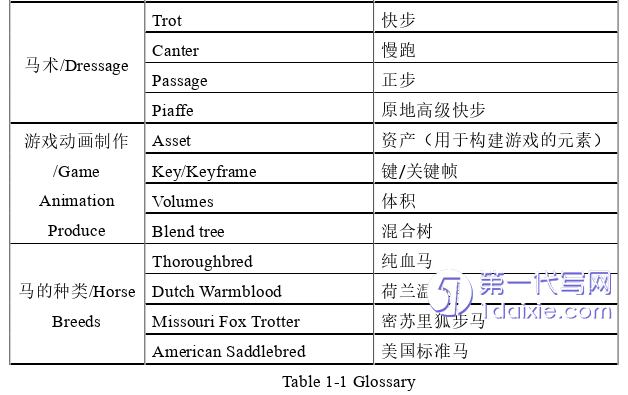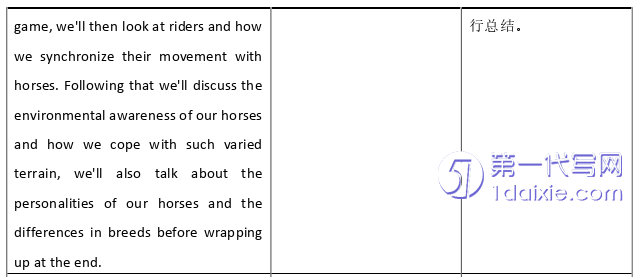本文是一篇英语论文,本文是一篇英汉模拟交传实践报告,所选取的翻译任务是2021年游戏开发者大会上由Tobias Kleanthous所做的演讲《如何制作<荒野大镖客2>中栩栩如生的马》,该演讲详细阐述了关于游戏中马儿的制作过程,对国内的游戏厂商有很大的学习意义。
Chapter One Task Description
1.1 Background of The Task
GDC delivers five days of expert-led education on key game development, it provides the opportunity to gain insight into the future of games, be inspired by new techniques, and discover creative new approaches for all people who want to or already have engaged in this industry. Any participant could get ideas for new games, tips to push your project forward, learn how to create compelling interactions and design great games, or learn the latest tools, middleware, and technical skills to develop games across platforms and solve difficult development problems.
In this 2021 Game Developer Conference, Rockstar Games’ Tobias Kleanthous shares how they delivered a believable horse that could be the best support character to continue the story of Red Dead Redemption in people’s memories, and what kind of difficulties that they have encountered during development.

1.2 Content of The Task
“How to make a believable horse in ‘Red Dead Redemption Ⅱ’” focuses on introducing animation production of horses in the game, and the Rockstar team wanted to make sure that the horse will be the perfect support of Arthur, instead of a mere vehicle. Firstly, the team wants to unify the completely different locomotion systems of human, animal, and horse, with the core notion that, compared to the GTA series, Red Dead 2 is a slower-paced world and that horses are neither cars nor bicycles and need to be brought to life for them. In order to make the horses look as realistic as possible, Rockstar created thousands of small animations that were then dynamically stitched together in the game, including the horse’s turning, speed, and gaits, to present vivid horses that could respond to your instructions.
Rockstar team also created environmental awareness, the core concept of which is that the player should pay a price for the complex terrain, which will manifest itself in changes of sight, feel and speed. The fastest horse in the game can run at around 40 miles per hour, which is too fast and can cause accidents easily, making it necessary for the horses to have independent Artificial Intelligence (AI) to make their own decisions under certain circumstances.
The horse’s AI helps the player to avoid obstacles. The horse will recognize trees or large rocks on the map and avoid them naturally. In addition, horses could be frightened and agitated, which means they will have more movements and may throw the rider off their back. When they encounter predators, such as bears and crocodiles, they become frightened and may try to escape if you don't calm your horse.
Chapter Two Consecutive Interpreting
2.1 Preparation for the Interpreting
Preparation for the interpreting is an extremely important part of the task and is the key to the success of an interpreting event. Preparation for interpreting is divided into long-term preparation and short-term preparation. “There is no meeting that does not need to be prepared for any interpreter. The more familiar to the industry terms, the more well-known the interpreter will be, and that leads to listening improvement.” (Seleskovitch, 1992:136). Dr. Chao-Lun Lin, the chief interpreter of the British Foreign Office, divides the interpreting cycle into five stages: acceptance of the task, pre-preparation, on-site interpreting, self-assessment after the task, and filling learning gaps (2004:35). Long-term preparation refers to solid basic bilingual skills and extensive background knowledge. Short-term preparation, on the other hand, refers to an interpreter's fast understanding of relevant professional knowledge, terminology, speaker’s accents, and speaking habits, as well as understanding the target audience. Thus, the combination of long-term and short-term preparation could better help the interpreter finish an interpreting task.
2.1.1 Background Research
The more familiar the interpreter is with the conference theme and the more information he/she knows, the better he/she can understand the information received in the source language in an organized and logical manner, the more integrated the interpreter’s understanding, analysis, reasoning, and prediction will be, and the higher the quality of interpreting will be. In order to ensure the authenticity of the mock interpretation and simulate the most critical situation, that is, the conference is unable to provide any draft, PPT, or other relevant content, the interpreter needs to read a lot of relevant information and the more in-depth analysis, reasoning, and prediction, the smoother the interpreting task will be.
2.2 While-Interpreting
Because of the spreading pandemic all over the world, the 2021 GDC was held online. This simulated consecutive interpreting was also conducted online, via Tencent Conferences APP, to which the author invited fellow students to join as audience members. The author checked the equipment and network before the conference started to make sure it was working properly, and to avoid any emergency network problems, the author also prepared a backup network. After ensuring that everything was ready, the author started to play the audio, pausing every 1-2 minutes for interpreting, with the specific pause time based on the sense group, taking notes during listening, and at last, the whole mock consecutive interpreting lasted around 120 minutes. The preparation before interpreting and the glossary helped a lot, but there were still a lot of difficulties and problems with the delivery.
Firstly, the speaker is not a professional orator, he speaks very fast and some words are not clearly pronounced, which causes a lot of difficulty for the author. Secondly, the speaker has a lot of filler words, for example, he subconsciously starts each sentence with “so”, which in most cases does not have a logical meaning, but for the author, who is in a highly stressful state, it affects the understanding of the logic of the source language and the organization of the production in Chinese. Thirdly, the complex structure of the sentences and the large amount of information make it difficult for the author to deal with this situation, and a lot of information is missed under the stressful listening problem. Chapter Three Case Analysis ................................... 8
3.1 Complicated Sentence Structure ........................... 8
3.1.1 Division ............................ 9
3.1.2 Inversion ................................ 11
Chapter Four Conclusion ...................................... 16
4.1 Reflections on the Interpreting Practice ........................... 16
4.2 Limitations ........................................ 17
Chapter Three Case Analysis
3.1 Complicated Sentence Structure
The famous translator Gu Hongming once said that “The English are proud of the preciseness of their language, while we Chinese are proud of the conciseness of our mother tongue.” His words pointed out the major difference between Chinese and English, that is English is a hypotaxis language which lays stress on preciseness and logic, so that lead to strict grammar connection to build sentences. On the contrary, Chinese is a parataxis language, featuring with vivid and rather loose sentence structure, such as short simple sentences and coordinate construction. Understanding the difference between hypotaxis and parataxis is critical for interpreting practice and getting rid of the constrain of the language form.

In the process of the consecutive interpreting, the interpreter encountered the difficulties in interpreting complicated long sentences. In long and difficult sentences, some sentences have complex structures, and some sentences have a lot of information, and the timely nature of interpreting work makes it difficult to interpret accurately. At this time, it is especially necessary to use the methods of division, inversion and linear interpreting to convey ideas in one's own language. (Cook, G. 1992:167)
Chapter Four Conclusion
4.1 Reflections on the Interpreting Practice
First, preparation before interpretation is the foundation of the activity. A good start is half the battle. If you do not prepare well before interpretation, the quality of interpretation will definitely be reduced. The material for this interpretation practice features strong science and technology professional terms. If the preparation is not sufficient, and the interpreters are not sensitive to science and technology terms during interpreting, and he/she will involuntarily put more energy into the listening and analysis, which will lead to the reduction of energy allocation in other sessions, and eventually cause the phenomenon of misinterpretation, omission, and wrong logic. Only by making good preparations before interpretation and laying a solid foundation can we ensure the output of quality interpretation.
The last critical factor is good mental and physical qualities. Without them, in a highly stressful state, interpreters are prone to memory interruptions when encountering unfamiliar vocabulary, dense information, and serious accents, and are unable to interpret in time (Napier, 2004:124). This state inevitably affects subsequent interpretation, such as fragmented interpretation and filler words, like “e” and “um”, which bring a bad experience for the listener.
reference(omitted)
